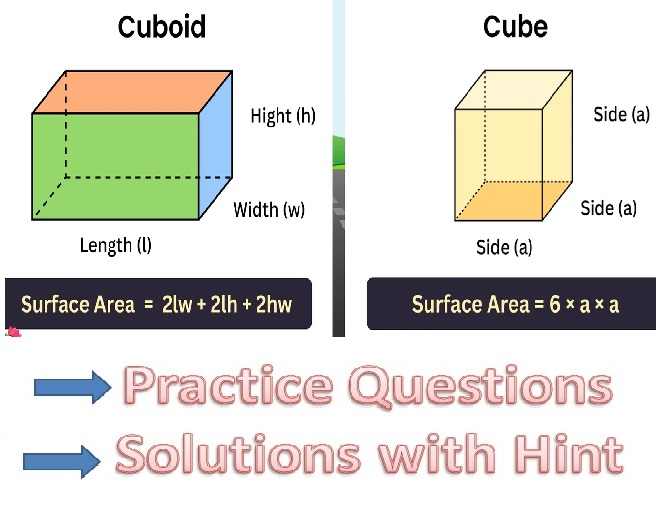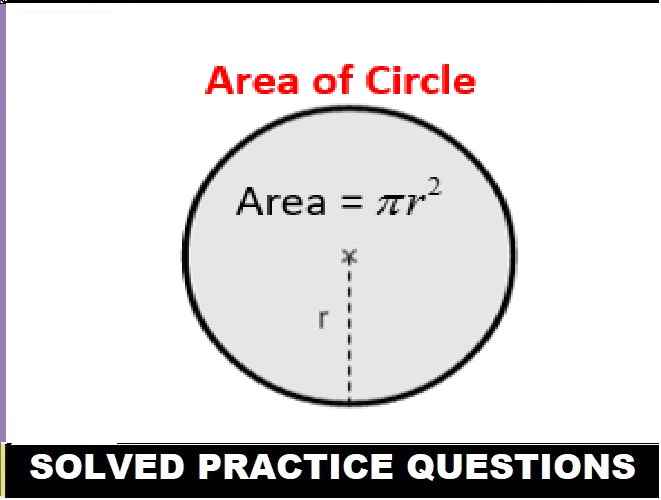ML Aggarwal Pythagoras Theorem Chapter Test Class 9 ICSE Maths Solutions Ch-12. Step by Step Solutions of Exercise-12 Chapter-Test Questions on Pythagoras Theorem of ML Aggarwal for ICSE Class 9th Mathematics. Visit official website CISCE for detail information about ICSE Board Class-9.
ML Aggarwal Pythagoras Theorem Chapter Test Class 9 ICSE Maths Solutions Ch-12
| Board | ICSE |
| Subject | Maths |
| Class | 9th |
| Chapter-12 | Pythagoras Theorem |
| Topics | Solution of Ch-Test Questions |
| Academic Session | 2024-2025 |
Solutions of Ch-Test Questions on Pythagoras Theorem
Question 1.
(a) In fig. (i) given below, AD ⊥ BC, AB = 25 cm, AC = 17 cm and AD = 15 cm. Find the length of BC.
(b) In figure (ii) given below, ∠BAC = 90°, ∠ADC = 90°, AD = 6 cm, CD = 8 cm and BC = 26 cm. Find :
(i) AC (ii) AB (iii) area of the shaded region.
(c) In figure (iii) given below, triangle ABC is right angled at B. Given that AB = 9 cm, AC = 15 cm and D, E are mid-points of the sides AB and AC respectively, calculate
(i) the length of BC (ii) the area of ∆ ADE.

Answer :
(a) Given AD ⊥ BC, AB = 25 cm, AC = 17 cm and AD = 15 cm
ADC is a right triangle.
⇒ 172 = 152+DC2
⇒ 289 = 225+DC2
⇒ DC2 = 289-225
⇒ DC2 = 64
Taking square root on both sides,
DC = 8 cm
ADB is a right triangle.
⇒ 252 = 152+BD2
⇒ 625 = 225+ BD2
⇒ BD2 = 625-225 = 400
BD = 20 cm
⇒ BC = BD+DC
= 20+8
= 28 cm
Hence the length of BC is 28 cm.
(b) Given BAC = 90°, ADC = 90°
AD = 6 cm, CD = 8 cm and BC = 26 cm.
(i) ADC is a right triangle.
⇒ AC2 = 62+82
⇒ AC2 = 36+64
⇒ AC2 = 100
Taking square root on both sides,
AC = 10 cm
Hence length of AC is 10 cm.
(ii) ABC is a right triangle.
⇒ 262 = 102+AB2
⇒ AB2 = 262-102
⇒ AB2 = 676-100
⇒ AB2 = 576
Taking square root on both sides,
AB = 24 cm
Hence length of AB is 24 cm.
(iii) Area of ABC = ½ ×AB×AC
= ½ ×24×10
= 120 cm2
Area of ADC = ½ ×AD×DC
= ½ ×6×8
= 24 cm2
Area of shaded region = area of ABC- area of ADC
= 120-24
= 96 cm2
Hence, the area of shaded region is 96 cm2.
(c) Given B = 90°
AB = 9 cm, AC = 15 cm .
D, E are mid-points of the sides AB and AC respectively.
(i) ABC is a right triangle.
⇒ 152 = 92+BC2
⇒ 225 = 81+BC2
⇒ BC2 = 225-81
⇒ BC2 = 144
Taking square root on both sides,
BC = 12 cm
Hence, the length of BC is 12 cm.
(ii) AD = ½ AB [D is the midpoint of AB]
AD = ½ ×9 = 9/2
⇒ AE = ½ AC [E is the midpoint of AC]
⇒ AE = ½ ×15 = 15/2
ADE is a right triangle.
⇒ (15/2)2 = (9/2)2+DE2
⇒ DE2 = (15/2)2 – (9/2)2
⇒ DE2 = 225/4 -81/4
⇒ DE2 = 144/4
Taking square root on both sides,
DE = 12/2 = 6 cm.
Area of ADE = ½ ×DE×AD
= ½ ×6×9/2
= 13.5 cm2
Therefore, the area of the ADE is 13.5 cm2.
Question 2. If in ∆ ABC, AB > AC and DI BC, prove that AB² – AC² = BD² – CD².
Answer : Given AD BC, AB>AC
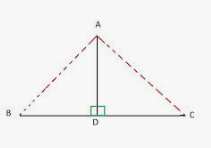
So ADB and ADC are right triangles.
Proof:
In ADB,
⇒ AD2 = AB2-BD2 …(i)
In ADC,
AC2 = AD2+CD2
⇒ AD2 = AC2-CD2 …(ii)
Equating (i) and (ii)
AB2-BD2 = AC2-CD2
AB2-AC2 = BD2– CD2
Hence proved.
Question 3. In a right angled triangle ABC, right angled at C, P and Q are the points on the sides CA and CB respectively which divide these sides in the ratio 2:1. Prove that
(i) 9AQ² = 9AC² + 4BC²
(ii) 9BP² = 9BC² + 4AC²
(iii) 9(AQ² + BP²) = 13AB².
Answer : Join AQ and BP, Given C = 90°
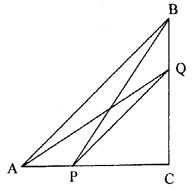
Proof: (i) In ACQ,
Multiplying both sides by 9
9AQ2 = 9AC2+9CQ2
⇒ 9AQ2 = 9AC2+(3CQ)2 …(i)
Given BQ: CQ = 1:2
⇒ CQ/BC = CQ/(BQ+CQ)
⇒ CQ/BC = 2/3
⇒ 3CQ = 2BC …(ii)
Substitute (ii) in (i)
9AQ2 = 9AC2+(2BC)2
⇒ 9AQ2 = 9AC2+4BC2 …(iii)
Hence, proved.
(ii) In BPC,
Multiplying both sides by 9, we get
9BP2 = 9BC2+9CP2
⇒ 9BP2 = 9BC2+(3CP)2 …(iv)
Given AP: PC = 1:2
CP/AC = CP/AP+PC
⇒ CP/AC = 2/3
⇒ 3CP = 2AC …(v)
Substitute (v) in (iv)
9BP2 = 9BC2+(2AC)2
⇒ 9BP2 = 9BC2+4AC2 …(vi)
Hence proved.
(iii) Adding (iii) and (vi), we get
9AQ2+9BP2 = 9AC2+4BC2+9BC2+4AC2
⇒ 9(AQ2+BP)2 = 13AC2+13BC2
⇒ 9(AQ2+BP)2 = 13(AC2+BC2) …(vii)
In ABC,
AB2 = AC2+BC2 …(viii)
Substitute (viii) in (viii), we get
9(AQ2+BP)2 = 13AB2
Hence proved.
Question 4. In the given figure, ∆PQR is right angled at Q and points S and T trisect side QR. Prove that 8PT² – 3PR² + 5PS².
Answer : Q = 90° given
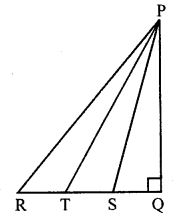
S and T are points on RQ such that these points trisect it.
So RT = TS = SQ
To prove : 8PT² = 3PR² + 5PS².
Proof:
Let RT = TS = SQ = x
In PRQ,
⇒ PR2 = (3x)2+PQ2
⇒ PR2 = 9x2+PQ2
Multiply above equation by 3
3PR2 = 27x2+3PQ2 …(i)
Similarly in PTS,
⇒ PT2 = (2x)2+PQ2
⇒ PT2 = 4x2+PQ2
Multiply above equation by 8
8PT2 = 32x2+8PQ2 …(ii)
Similarly in PSQ,
⇒ PS2 = x2+PQ2
Multiply above equation by 5
5PS2 = 5x2+5PQ2 …(iii)
Add (i) and (iii), we get
3PR2 +5PS2 = 27x2+3PQ2+5x2+5PQ2
⇒ 3PR2 +5PS2 = 32x2+8PQ2
⇒ 3PR2 +5PS2 = 8PT2 [From (ii)]
8PT2 = 3PR2 +5PS2
Hence proved.
Question 5. In a quadrilateral ABCD, ∠B = 90°. If AD² = AB² + BC² + CD², prove that ∠ACD = 90°.
Answer :

B = 90˚ in quadrilateral ABCD
AD² = AB² + BC² + CD²
To prove: ACD = 90°
Proof: In ABC,
AC2 = AB2+BC2 …(i)
Given, AD² = AB² + BC² + CD²
⇒ AD² = AC2+CD2 [from (i)]
In ACD, ACD = 90° [Converse of Pythagoras theorem]
Hence proved.
Question 6. In the adjoining figure, find the length of AD in terms of b and c.
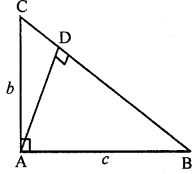
Answer : given A = 90° , AB = c , AC = b
ADB = 90°
In ABC,
⇒ BC2 = b2+c2
⇒ BC = √( b2+c2) …(i)
Area of ABC = ½ ×AB×AC
= ½ ×bc …(ii)
Also, Area of ABC = ½ ×BC×AD
= ½ ×√( b2+c2) ×AD …(iii)
Equating (ii) and (iii)
½ ×bc = ½ ×√( b2+c2) ×AD
⇒ AD = bc /(√( b2+c2)
Therefore,
AD is bc /(√( b2+c2).
Question 7. ABCD is a square, F is mid-point of AB and BE is one-third of BC. If area of ∆FBE is 108 cm², find the length of AC.
Answer : Let x be each side of the square ABCD.
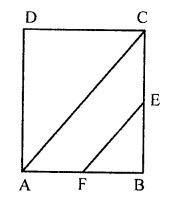
FB = ½ AB [∵ F is the midpoint of AB]
FB = ½ x …(i)
BE = (1/3) BC
⇒ BE = (1/3) x …(ii)
AC = √2 ×side
⇒ AC = √2x
Area of FBE = ½ FB×BE
108 = ½ × ½ x ×(1/3)x [given area of FBE = 108 cm2]
⇒ 108 = (1/12)x2
⇒ x2 = 108×12
⇒ x2 = 1296
Taking square root on both sides.
x = 36
AC = √2×36 = 36√2
Therefore,
length of AC is 36√2 cm.
Question 8. In a triangle ABC, AB = AC and D is a point on side AC such that BC² = AC x CD, Prove that BD = BC.
Answer : In ABC, AB = AC
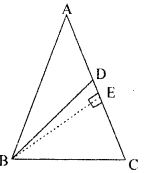
D is a point on side AC such that BC² = AC×CD
To prove : BD = BC
Construction: Draw BEAC
Proof: In BCE ,
⇒ BC2 = BE2+(AC-AE)2
⇒ BC2 = BE2+AC2+AE2– 2 AC×AE
⇒ BC2 = BE2+AE2+AC2– 2 AC×AE …(i)
In ABC,
AB2 = BE2+AE2 …(ii)
Substitute (ii) in (i)
BC2 = AB2+AC2– 2 AC×AE
⇒ BC2 = AC2+AC2– 2 AC×AE [∵AB = AC]
⇒ BC2 = 2AC2-2 AC×AE
⇒ BC2 = 2AC(AC-AE)
⇒ BC2 = 2AC×EC
BC² = AC × CD
⇒ 2AC×EC = AC × CD
⇒ 2EC = CD …(ii)
E is the midpoint of CD.
EC = DE …(iii)
In BED and BEC,
EC = DE [From (iii)]
BE = BE [common side]
BED = BEC [By SAS congruency rule]
BD = BD [c.p.c.t]
Hence proved.
— : End of ML Aggarwal Pythagoras Theorem Chapter Test Class 9 ICSE Maths Solutions :–
Return to :- ML Aggarawal Maths Solutions for ICSE Class-9
Thanks
Please Share with Your Friends

